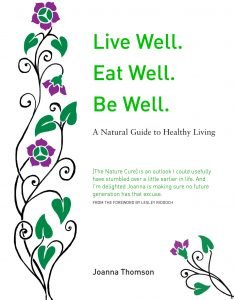Thomson Kingston Publications
These PDFs are created from the original Thomson Kingston booklets and are here for you to read on line or to download. Most of the original booklets are also still available to buy. Please use the Contact Us form for more information and if you would like to sent a booklist.
You might be wondering why we are asking you to pay for the PDFs. The Tait Vision Fund Trustees discussed this question and their feeling was that it was reasonable to ask for a small contribution for them. These small payments all add up and will enable us to continue our important work.
The PDFs are presented in the original style and some of you might find the wording rather old-fashioned and the tone a little paternalistic. Get past this and you will find the pure gold of the timeless information about good health.
ALL IN ONE BOOK
If you would like a single book that distils the vital information from the publications into a single volume then perhaps you would like the new book Live Well, Eat Well, Be Well, written, updated and edited by the granddaughter of the founders of the Kingston Clinic. Published by Luath Press in December 2016. All proceeds from the sales go to the Tait Vision Fund.
Catarrhal Tendencies
CATARRHAL TENDENCIES
by C. Leslie Thomson
Catarrh, in one form or another, is so widespread a condition that one need offer no apology for examining the subject more fully.
In one sense, it is the most important of all simple disease states, since the manner of its treatment may decisively influence the individual’s future. Properly understood and rationally handled, a catarrhal system is capable of rectifying itself in an almost astonishingly complete way: treated suppressively, the body may become so handicapped that there is no limit to the unpleasantness that may develop. In early stages, there may be tonsillitis, sinusitis, and earache: in more advanced cases the breakdown may be evident as asthma, hay fever and pneumonia: still worse, one may find mastoid inflammation, diphtheria and tubercular breakdown.
Breathe High, Wide & Handsome
BREATHE HIGH, WIDE & HANDSOME
by C. Leslie Thomson
To perform its marvellously varied functions, the human body requires energy: so far as we can determine, this energy comes from combustion. That is by no means a rigid fact, but for all practical purposes we are kept going by the oxidation of fuel within our tissues, plus a variable contribution of direct radiation from the sun. There appears to be no reason to consider human energy as a mystic or super-‐natural phenomenon. This being so, we may adopt a fairly objective and materialistic attitude to the problems associated with our energy, or lack of it.
Just as oil or solid fuel burns in a furnace, so do the body’s particular forms of fuel burn within its cells, releasing energy in a variety of forms. In a muscle-‐cell, for example, the greater part of the energy appears, through a series of complex steps, as a contraction that may help to move a limb. In a different way, although still using the same basic fuel and still requiring oxygen to ‘burn’ it, a nerve cell produces impulses that may be roughly described as electrical. These impulses may serve a wide variety of purposes; sending information to the brain in the form of sight, sound, feeling, pain, taste, smell etc., or instructing a muscle to contract or a stomach to secrete digestive juices.
High & Low Blood Pressure
HIGH AND LOW BLOOD PRESSURE
Leslie Thomson
FOREWORD
A couple of years after writing his classic The Heart, James C. Thomson produced a companion work, High and Low Blood Pressure, which extended the principles to a wider field. The second book was regularly reprinted over about twentyZthree years, but the publishers decided against further issue after 1962. We still receive requests for the book, and what follows is an attempt to reZstate the essential points in a concise fashion.
CHAPTER”1 — CLARIFICATION
Many unfortunates have been told that they suffer from ‘blood pressure’ but few are given any explanation of what that signifies. Often it means little in itself, but may give rise to serious anxieties. Often the diagnosis is incorrect, because too little regard is given to the whole state of the patient. Even where diagnosis is technically accurate, the treatment based thereon may be inappropriate, because the physician has failed to recognise primary causes and directs his efforts at suppressing symptoms. These comments may themselves seem to lack positive value, but their significance should become clear as we proceed. Even the gravest abnormality of blood pressure is but a symptom of some irregularity of structure or function elsewhere, and it often calls for real patience to follow the links and so discover what adjustments are necessary; even more patience to persevere with the reforms which these entail.
Be Kind to your Kidneys
BE KIND TO YOUR KIDNEYS
by C. Leslie Thomson
Often, a new patient will express mild surprise—perhaps even downright incredulity—when we suggest that disordered kidneys are an important factor in their condition. The patient may have come to us because ‘of a skin irritation, some form
of respiratory weakness or nagging headaches: perhaps the main symptom may be rheumatic or apparently cardiac distress. Even if none of these, we consider it an essential part of all preliminary consultations to assess the efficiency of the kidneys. Only rarely do we find these organs exempt from the overall bodily disease.
A Clear Head
A CLEAR HEAD
By C. LESLIE THOMSON.
Of all the seemingly minor ailments one may suffer -‐ things scarcely painful or crippling enough to rate as “real diseases” -‐ a feeling of being not quite clear-‐headed is one of the worst. In different people, it takes varying forms: in some, it shows mainly as poor memory; in others a difficulty in finding the right word; still others may have occasional spells of feeling slightly “unreal ” or, and this is the most usual complaint, there may be a vague and generalised sensation of cotton-‐woolliness which makes the head feel thick and the senses dulled.



